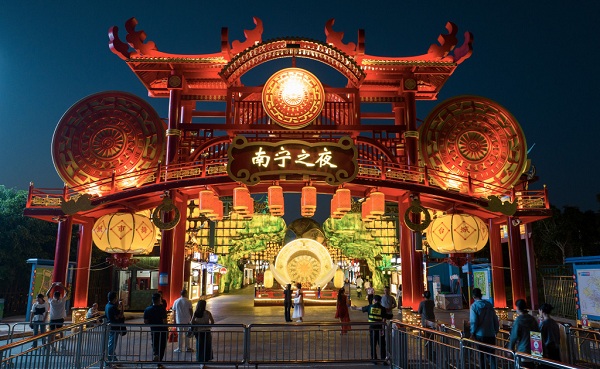Night fairs heat up winter consumption in south China

People stroll at a night market in Nanning, Guangxi Zhuang autonomous region on Oct 30, 2023. Over the recent years, Guangxi has put great effort in developing night-time economy. [Photo/VCG]
At 8 pm, the tantalizing aroma of Cai Zhuocheng's shrimp cakes filled the air as they sizzled in the frying pan, enticing late-night diners at "The Night of Nanning."
After quitting his job as a salesperson of tech products earlier this year, Cai joined the army of street vendors at this bustling night market in Nanning, capital of south China's Guangxi Zhuang autonomous region.
"Consumption has been on the rise as people are venturing out to splurge," said Cai, who initially set up the stall, so it could tide him over temporary unemployment while he sought a more desirable job.
However, as the profits from his small food stall exceeded 7,000 yuan (about $987) on busy nights, he opted to remain in the bustling market street adorned with the aroma of barbecue and stinky tofu.
"Compared with the 9-5 daily routine (of office work), I also find the flexible nature of managing a stall is more my speed," said Cai. "I'm now looking for new places to scale my venture."
Nighttime economy, referring to business activities between 6 pm and 6 am, once again became a trending topic this year as China strives to bolster domestic consumption along the post-COVID recovery path.
In particular, such businesses are thriving in many medium-sized cities in south China, which boast a slow-paced lifestyle, a vigorous nightlife culture and a warmer climate that allows nocturnal revelry to rage into winter.
"The Night of Nanning," for instance, saw over 3 million visitors in the first 50 days after the night fair opened in January to pool together eateries, funfairs and live performances.
Almost a year later, the market, now boasting over 160 shops, continues to attract a steady stream of visitors, averaging 12,000 daily during the winter months, according to the fair's management.
It is one epitome of the booming nighttime economy of Guangxi, which reached 930 billion yuan in 2022 and is likely to surpass 1 trillion yuan this year.
Lai Fuqiang, deputy head of Guangxi's culture and tourism department, said nearly 200 nighttime activities have been launched in the region in an attempt to attract more non-local tourists during winter, when tourists from the north flock to Guangxi to savor its warmer weather.
In some cities, the nighttime tourism sector is already in the process of blending with distinctive local cultures, tourism and sports.
Liuzhou, an industrial city in Guangxi and the birthplace of the pungent snail noodle, has built a neon-lit retro town that features shops where visitors can try on ethnic costumes and enjoy a dazzling array of folk culture activities after sunset.
With its diverse nighttime offerings, this Yaobu Old Town has burnished its image as the paradise for "special forces" tourism, a hip choice among young Chinese looking to make the best out of short holiday breaks.
This year, the regional capital Nanning also rolled out night cruise tours along the Yongjiang River which runs through the city, gaining popularity among newcomers to the town.
"From a vibrant late-night food scene to nighttime commercial and tourism clusters, the nighttime tourism sector is heading steadily toward high-quality growth," Lai said.
Experts believe that China's nighttime economy is still in a nascent stage with much room for growth.
"Currently the sector centers around night tours, night markets and food streets, while there is still room for improvement through (nighttime) entertainment, sports, exhibitions and performances," said Niu Lei, a researcher with the Tianjin Academy of Social Sciences.
Cai, who is working to expand his menu, also feels the urge to upgrade. "It's a business with immense potential for growth. But to avoid losing steam in a long run, we will have to adapt and diversify," he said.














